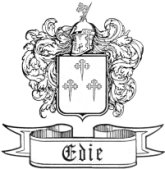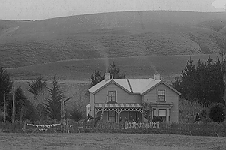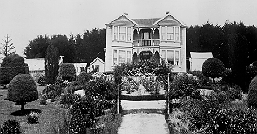Springfield - The Home of the Edies
An interesting summation and insight into the farming achievement of John and Mary and their children is provided by the detailed news report of 11th April 1900 entitled "Springfield" Farm. It shows a thriving farm enterprise.
The reporter begins his piece by describing the situation of the house.
"Mr. Edie’s home is situated on the north side of the main road to Tapanui and Lawrence, and is surrounded by a nice plantation of forest trees and as the ground is of a rising altitude from the home, forming a breakwind from all directions, creates a pleasant atmosphere in summer and winter, of course helped greatly by the plantation, which is about 14 years old."
Later he describes it’s geographic location, which gives a good sense of the locale. "From the higher altitudes of the farm a very extensive view is obtained of all the country south right to the Hokanui’s, a distance of fully 40 miles, and along the Blue Mountains right to Tapanui; also of the Dunrobin rolling ridges and the lower undulating ridges, valleys, and plains of Herriot and Crookston." The reporter also points out that "Church and schools are within three miles." Someone selling the property couldn’t have created a better description!
"The dwelling house is a two-storey building, large, airy, and commodious, and fronting the main road. A little way to the rear is a conservatory, which Mrs. Edie superintends, and of which she is justly proud. The vines looked very well, in full bearing with grapes, and the front being to the sunny side is exposed to the sun all day.
Detached conveniently is a store room, coal house, dairy and wash house, all of which are situated a little to the rear of the dwelling."
Perhaps the skills of "The Long-race Sluicing Co." were used in the design and construction of the watersupply, for
"Water for domestic purposes is conveyed by pipes fully a quarter of a mile from a spring, led into a tank inside, and when overflowing is conveyed by piping to a watering trough conveniently placed for the stable so that horses can be watered on coming in from their work and going out in the morning.
The overflow from the trough is carried away by a tile drain. This leaves all the surroundings clean and dry, with the advantage of having clean pure water for all purposes."
The grapes were not the only fruit to be grown. "The orchard is well stocked with large fruit trees (apples etc.), numbering about 50, and in addition to which there is an area under small fruit trees, all well sheltered by the plantation."
Other crops which were grown were wheat, oats, grass, and turnips which were described as thriving immensely. The remaining wealth of the farm came from sheep, 4 cows, and household chickens. A piggery was also part of this self-sufficient enterprise. In comparison to the deprived conditions of the Scotland they had left behind, this must have seemed like a cornucopia of economic freedom and security, which gave a healthy life for their children.
The farm buildings are described extensively, as befits the content of a rural paper of that era.
"The buildings at the homestead comprise a nine-stalled stable with loft. At the rear is an engine shed where a five-horse-power steam engine is placed; and on the stable loft a chaff-cutter is worked by the engine together with a corn crusher (Booth and Macdonald makers), which does the crushing speedily and satisfactorily.
The oats when crushed are elevated into a central recess, from which all the feed boxes can be served without any trouble. A shaft is erected in such a way that it is driven by the engine, so as to drive grass seed cleaning machinery and fanners - all local engineering combined with marked economy; and several parts of old binders have been brought into satisfactory use for regulating speed, etc."
This attests to the ingenuity of the Edie’s, not only in using new technology, but networking imported machinery with local engineering to form a local solution. More machinery also is mentioned in detail, as is some equipment to battle the ubiquitous rabbit.
"Adjoining the stable is a buggy shed, sufficiently large to keep many tons of rabbit netting, fencing wire, and other necessary tools, besides buggies. The barn is 30ft by 16ft with 14ft walls and loft. The two floors will contain 900 bags which are stored there until after all farm work is done in the spring.
The implement shed permits the greater part of the machinery being kept under cover (an unspeakable benefit both for wood and iron work). Implements and machinery comprise the best makes, and include two binders (Hornsby and Wood), Reid and Gray seed sowing machine (for wheat and manure, and also for turnips and manure combined). Cousin and Black’s broad-cast grin and grass seed machine (18ft wide ), two double farrow ploughs (Reid and Grey), one double farrow digger-plough (Howard), two sets of 18ft harrows, two sets 18ft chain harrows, Massey-Harris cultivator, two planet Jr’s (which are giving much satisfaction and which Mr. Edie recommends to farmers), two six-horse wagons and two road drays."
This degree of mechanisation was balanced by a self-sufficient home economy, where cows, fowls and pigs were kept also.
The author also goes on to describe in some detail the woolshed! He next turns his attention to the structure of the farm:
"The farm is subdivided into 14 paddocks, containing from 20 up to 80 acres each. Fences (of which there are about 12 miles on the farm) are erected on a most substantial principle - gates 18ft 6 inches wide hang with 4ft hinges and bolted - posts of broadleaf and black pine of the best quality, 5in by 4in and 5ft 6in long. The height of the fence is 3ft 4in, comprising six wires and barb, fitted with Reid’s patent triplex at every strain. There are 19 fields under English grass for pasture, which I noted had a splendid close sole. The grasses sown are 1 bushel ryegrass, 18 lb cocksfoot, 3lb timothy, 9lb white clover, 2lb cowgrass and 2lb alsike per acre. Mr. Edie tells me that he renews them not longer than every fourth year, but considers that if possible a farmer ought to have a field of young grass every year, thus enabling him to carry a larger number of sheep to the acre. Springfield carries about 1800 sheep all year round, with the help of turnips in the winter."
The nature of the fertility of the land is the next aspect of the farm to which he turns his attention.
"The nature of the land on this property is of a loose sandy loam of brownish color(sic). The subsoil is of great depth and the deeper the more pliable it becomes. Mr. Edie told me he had grown up to 74 bushels of wheat and about 25 bushels of oats to the acre, and root crops, (especially turnips) do exceedingly well, helped of course by the best brands of manure. Grain and root crops are grown with about 2cwt of artificial manure to the acre. A white thorn hedge had grown immensely and is to be seen on both sides of the road as you approach the homestead, and giving a comfortable and homely appearance to the place as the spring time brings flowers. On the east side of the main road to Tapanui there is a belt of forest trees of fully 18 chains, forming a breakwind from the prevailing nor’westers, for many chains back from the road - so far, in fact, that a 40 acre paddock is sheltered by it. Mr. Edie gets all the firewood he requires for domestic purposes from the plantation."
This presents an in-depth picture of a flourishing, self-supporting farm which is creating wealth for the Edie family. This wealth has been used to revisit the site of their youth.
"In conversation with Mr. Edie about his tour over England, Ireland and Australia, he said he had come to the conclusion, considering all his surroundings, that he would rather stay at Springfield, for the simple reason that the land is as reproductive as in any other country, and the climate suitable for the health and well being of man and beast."
"DUNDONALD" PROPERTY
The reporter turns his attention from Springfield to the Dundonald property.
"Mr. Edie purchased this property from Mr. John McKinnon in 1897. It was formerly a part of the Moa Flat estate, and comprises about 2700 acres, mostly hilly country that will take well for surface sowing of grass. It has a northerly aspect, lying well to the sunny side. The present proprietor tells me that he expects to break up and improve about 1000 acres, consisting of broad ridges facing the sun.
Considerable improvements have been made, and about 300 acres brought under the plough, and now bearing about 150 acres of a really good crop of turnips, consisting of Aberdeen, purple and yellows, and about 25 acres of ‘Elephant’ swedes in drills, which look a crop not easily beaten. About 75 acres are in oats, sown down with grass. The ring fence is about nine miles, along all of which Mr. Edie intends to erect rabbit-proof wire netting. Two miles of netting are now completed in a workmanlike manner. This property is only about one mile from the homestead, and no doubt will work admirably with it."
This conclusion of the reporter is probably correct; however I wonder if the rabbit-proof fencing would work! What it does show us is the continual building of the farm that went on. It was obviously not enough for John and Mary to just be content with a small achievement.


